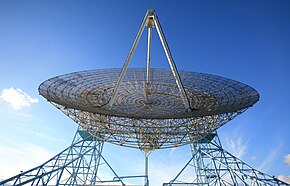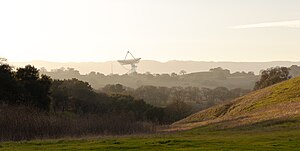 | |
| Alternative names | The Dish |
|---|---|
| Location(s) | California, Pacific States Region |
| Coordinates | 37°24′30″N 122°10′44″W / 37.4083°N 122.179°W |
| Organization | SRI International |
| Telescope style | radio telescope |
| Diameter | 150 ft (46 m) |
| Website | dish |
| | |


The Stanford Dish, known locally as the Dish, is a radio antenna in the Stanford foothills. The 150-foot-diameter (46 m) dish was built in 1961 by the Stanford Research Institute (now SRI International). The cost to construct the antenna was $4.5 million, and was funded by the United States Air Force.[1] In the 1960s the Dish was used to provide information on Soviet radar installations by detecting radio signals bounced off the moon.[2]
Later on, the Dish was used to communicate with satellites and spacecraft. With its unique bistatic range radio communications, where the transmitter and receiver are separate units, the powerful radar antenna was well-suited for communicating with spacecraft in regions where conventional radio signals may be disrupted.[3]
At one point, the Dish transmitted signals to each of the Voyager craft that NASA dispatched into the outer reaches of the solar system.[4] In 1982 it was used to rescue the amateur radio satellite UoSAT-1.[5]
- ^ "Radar Dish Erected on SU Campus". The Stanford Daily. Vol. 140, no. 7. October 2, 1961. p. 1. Retrieved 4 December 2019.
- ^ Eliot, Frank. "Moon Bounce Elint". CIA. Archived from the original on 2020-11-08. Retrieved 25 March 2019. (Also available as scanned PDF)
- ^ Tuchinsky, Evan. "Stanford Golf Course: A Historical Tour". Archived from the original on 10 March 2007. Retrieved 4 December 2019.
- ^ "Voyager: The Grand Tour of Big Science". NASA. Retrieved 20 June 2015.
- ^ Hora, Reenita Malhotra (2019-11-05). "Tech History: The Story Behind Stanford's Satellite Dish Hiking Trail in Palo Alto". Medium. Retrieved 2020-05-15.
